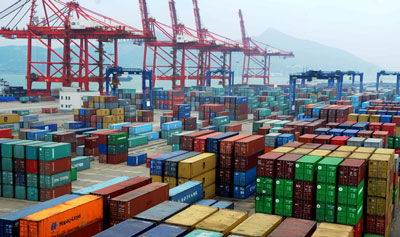China imports slump 20% amid falling commodity prices and weak demand

Imports were down for the 11th month in a row, according to official figures, but there are signs that demand for the country’s exports is picking up
China’s imports fell heavily in September, official figures said, keeping pressure on policymakers to do more to stave off a sharper economic slowdown.
Although exports fell less than expected by 3.7% from the same period last year, the value of imports tumbled more than 20% to register the 11th straight month of falls.
Imports plunged 20.4% in September from a year earlier to $145.2bn, customs officials said, due to weak commodity prices and soft domestic demand.
These factors will complicate Beijing’s efforts to stave off deflation, one of the headwinds threatening the world’s second biggest economy.
Stock markets in Asia Pacific fell back after the release of the data, with the Nikkei in Tokyo down 1.1%, the Hang Seng index in Hong Kong down 0.53% and the Shanghai Composite down 0.225. The ASX200 in Australia fell 0.57%.
Highlighting persistent weakness in demand at home and abroad, China’s combined exports and imports fell 8.1% in the first nine months of the year from the same period in 2014, well below the full-year official target of 6% growth.
“In general, there are no green shoots in this set of data,” said Zhou Hao, senior economist at Commerzbank in Singapore. “The growth of [trade] volume still remains low.”
However, monthly figures were much more rosy. Exports to every major market except Taiwan rose from August, as did imports.
Julian Evans-Pritchard of Capital Economics said monthly trends showed a steady rise to most major export markets in the US and Europe over the summer.
“Basically, exports have been doing better since the second quarter, but that recovery trend has been masked on a year-on-year basis because the second half of 2014 was so strong.”
Evans-Pritchard also said that import data had become unreliable given massive swings in prices due to the commodity downturn and a divergence between prices and trading volumes.
“For the major commodities like oil, copper, etc. we’re actually seeing a pretty healthy trend in import volumes.”
Import volumes are a leading indicator for exports in China, given a large share of materials and parts re-exported as finished goods.
“September’s import figure does not bode well for industrial production and fixed asset investment,” wrote ANZ economists in a research note reacting to the figures.
“Overall growth momentum last month remained weak and third quarter GDP growth to be released [on 19 October] will likely have edged down to 6.4%, compared with 7% in the first half.”
China posted trade surplus of $60.34bn for the month, the general administration of Customs said on Tuesday, higher than forecasts for $46.8 billion.
China is widely expected to post its slowest economic growth in a quarter of a century this year as activity is weighed down by weak demand, entrenched factory overcapacity, high debt levels and cooling investment appetite.
That is denting any remaining hopes that a recovery in China’s domestic demand might offset weakness elsewhere.
Source: The Guardian – China imports slump 20% amid falling commodity prices and weak demand



























